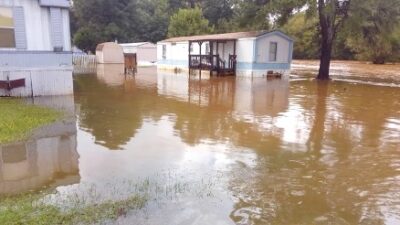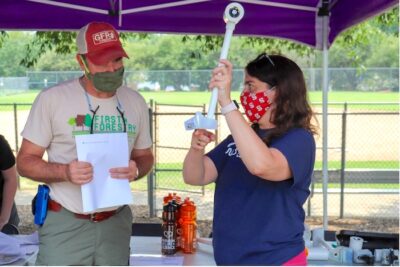By Suzanne Hollis
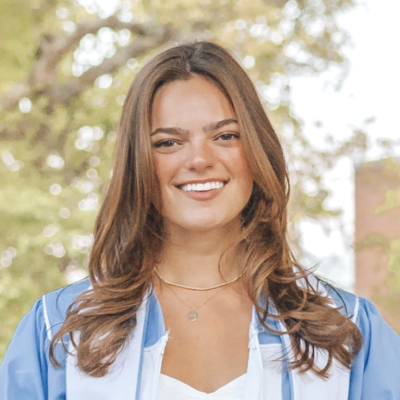 During Dr. Michele Steinberg’s summary of wildfire history, she notes that in 2018 six wildfires accounted for $12.35 billion in losses. The history of wildfires and how they occur has led to what we have learned and where we should place our efforts. The occurrence and severity of wildfires is increasing, however, the lessons we have learned can help reverse this: wildfires are inevitable and necessary in many ecosystems. During large wildland/urban fires hundreds of structures an hour may be ignited, and no fire suppression system in the world can stop losses from large conflagrations. Dr. Steinberg’s comments on mitigation and preventive actions reminded me of our previous lecture Engineering with Nature for Enduring Resilience given by Dr. Todd Bridges. Our actions have disrupted the environment’s natural fire prevention.
During Dr. Michele Steinberg’s summary of wildfire history, she notes that in 2018 six wildfires accounted for $12.35 billion in losses. The history of wildfires and how they occur has led to what we have learned and where we should place our efforts. The occurrence and severity of wildfires is increasing, however, the lessons we have learned can help reverse this: wildfires are inevitable and necessary in many ecosystems. During large wildland/urban fires hundreds of structures an hour may be ignited, and no fire suppression system in the world can stop losses from large conflagrations. Dr. Steinberg’s comments on mitigation and preventive actions reminded me of our previous lecture Engineering with Nature for Enduring Resilience given by Dr. Todd Bridges. Our actions have disrupted the environment’s natural fire prevention.
By preventing natural wildfires from occurring, fuel in the form of dead foliage builds up dangerously so when a wildfire occurs it reaches the canopies and becomes uncontrollable. Rather than trying to reduce wildfires with human made solutions, disconnected from the ecosystem, we need to learn from the environment and lean into natural solutions. Dr. Steinberg notes American beliefs and attitudes towards wildfire, which Firewise USA is attempting to readjust through education: that wildfire is the enemy, it is the firefighter’s job to rescue me, nobody can tell me what to do with my property, but the government should aid me after a disaster, I am helpless in the face of wildfire, and there is nothing I can do to reduce my risk.
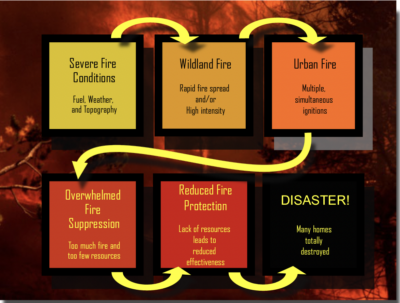
Dr. Steinberg placed great emphasis on the idea that wildfire prevention is a local effort, and that individuals are responsible for wildfire prevention mitigation. I think this is an interesting point, because currently our society is seeing a shift in the perception that climate change mitigation must be fronted by governments and larger companies rather than the individual. The attitude towards climate change and sustainability used to be that every individual must take on responsibility and take action, however, since what we know about solutions and mitigation has increased, the public perception of responsibility has shifted. This is the opposite from wildfire prevention. Wildfires used to be an uncontrollable force of nature, in which individuals had no power over. However, I have spent most of my summers in Idaho, with the understanding that preventing wildfire is an individual responsibility. My time in Idaho has also shown me that the efforts to educate communities about wildfires is in my opinion one of the best initiatives. When I consider government-run educational initiatives, wildfire prevention comes to mind quickly.
Dr. Steinberg discussed the fact that wildfires are occurring in new places and in greater force. This means that fires are occurring in areas that are not prepared for wildfires. There is certainly a lack of education about wildfire mitigation in these areas, so how will this harm prevention efforts? As climate change dries out and warms climates, wildfire risk and occurrence will continue to increase.
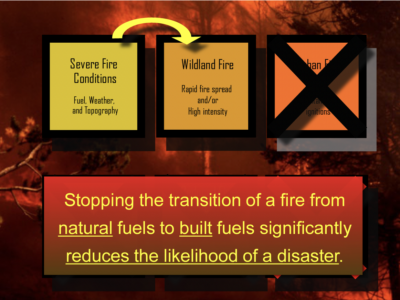
The parts of our country that are historically vulnerable to wildfires have preventative measures and education established. This is not the case for the rest of the country. Imagine living in a landlocked state, and having to react to a hurricane. There is no president, no education, and no habit to guide you. Living in Atlanta, I have never had to prepare for or react to an earthquake. How would I react to one, when I have not been prepared? As a country, we need to anticipate new vulnerable areas to wildfire, preemptively install resources and begin educating community members before it is too late.
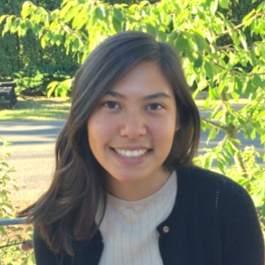


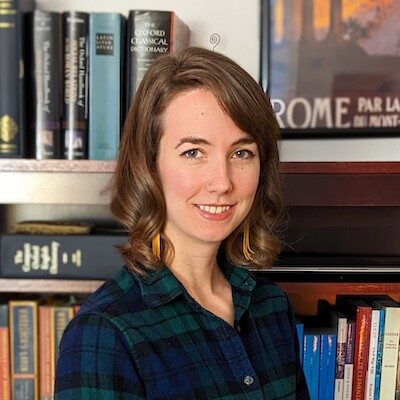 The Spring 2022 Natural Hazards Resilience Speaker Series began with a lecture by Dr. William Hooke, who emphasized the precariousness of humanity’s current position given that the instances of natural hazards will only increase, and likely in unpredictable ways – but his lecture also exuded optimism. I was struck by his faith in younger generations to effect change and move toward a hazard-resilient future.
The Spring 2022 Natural Hazards Resilience Speaker Series began with a lecture by Dr. William Hooke, who emphasized the precariousness of humanity’s current position given that the instances of natural hazards will only increase, and likely in unpredictable ways – but his lecture also exuded optimism. I was struck by his faith in younger generations to effect change and move toward a hazard-resilient future.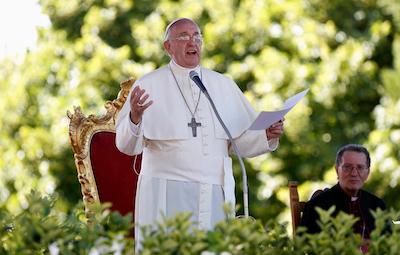
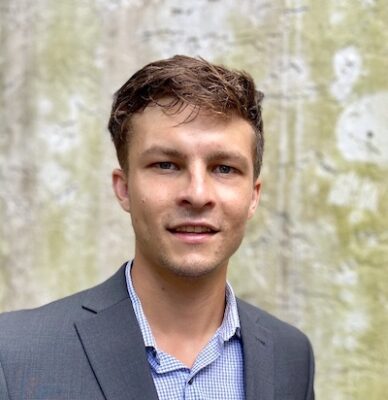 Spring Creek runs through Fort Collins to meet Colorado’s Cache La Poudre River. Where the creek flows under a bridge near the Dairy Queen, a placard marks the high-water line of the 1997 Spring Creek Flood. That storm was what experts call a 500-year flood. Statistically, such an event has a one-in-five-hundred chance of occurring in a given year, based on historical data.
Spring Creek runs through Fort Collins to meet Colorado’s Cache La Poudre River. Where the creek flows under a bridge near the Dairy Queen, a placard marks the high-water line of the 1997 Spring Creek Flood. That storm was what experts call a 500-year flood. Statistically, such an event has a one-in-five-hundred chance of occurring in a given year, based on historical data.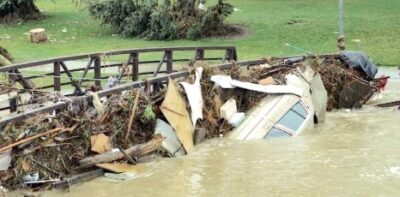
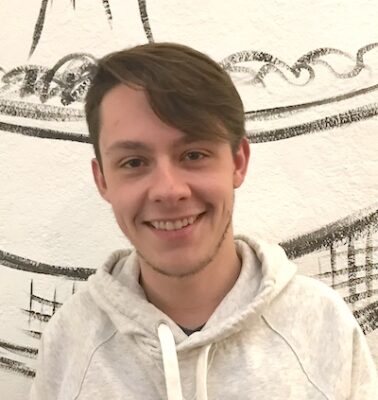 On February 15, 2022, the Natural Hazards Speaker Series class, hosted by the Department of City and Regional Planning, had the delight of hearing from Dr. Todd Bridges, the U.S. Army’s Senior Research Scientist for Environmental Science. Dr. Bridges’ presentation, “Engineering with Nature: Pursuing a New Arrangement with Nature”, began with a general overview of where we currently are with living with different kinds of hazards. To begin, Dr. Bridges explained what he calls the “Multi-Hazard World” in which we live with all kinds of different hazards whether they be industrial, climatological, or man-made/caused. Further, Dr. Bridges put into perspective just how much loss we incur by explaining that, since 1980, there have been 310 weather and climate-related disasters that have each totaled one billion dollars in damages for a combined total of 2.2 trillion dollars.
On February 15, 2022, the Natural Hazards Speaker Series class, hosted by the Department of City and Regional Planning, had the delight of hearing from Dr. Todd Bridges, the U.S. Army’s Senior Research Scientist for Environmental Science. Dr. Bridges’ presentation, “Engineering with Nature: Pursuing a New Arrangement with Nature”, began with a general overview of where we currently are with living with different kinds of hazards. To begin, Dr. Bridges explained what he calls the “Multi-Hazard World” in which we live with all kinds of different hazards whether they be industrial, climatological, or man-made/caused. Further, Dr. Bridges put into perspective just how much loss we incur by explaining that, since 1980, there have been 310 weather and climate-related disasters that have each totaled one billion dollars in damages for a combined total of 2.2 trillion dollars.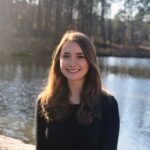
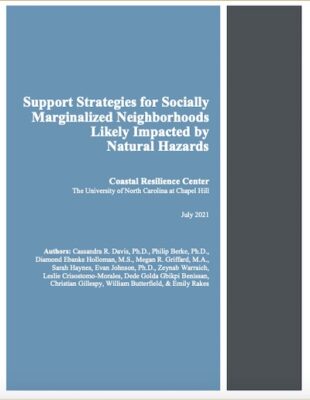
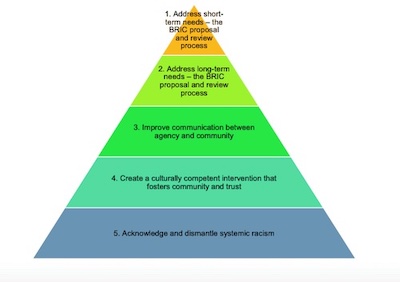
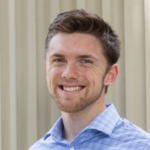 As the varied geography of North Carolina continually influences complex climatic conditions, the North Carolina State Climate Office is there, ever on the case. Officially designated as a North Carolina Public Service Center, the NC Climate Office collects and distills climate data into readily available information for decision-makers and citizens. At the top of the organization, heading a great team, is Kathie Dello, the North Carolina State Climatologist.
As the varied geography of North Carolina continually influences complex climatic conditions, the North Carolina State Climate Office is there, ever on the case. Officially designated as a North Carolina Public Service Center, the NC Climate Office collects and distills climate data into readily available information for decision-makers and citizens. At the top of the organization, heading a great team, is Kathie Dello, the North Carolina State Climatologist.
